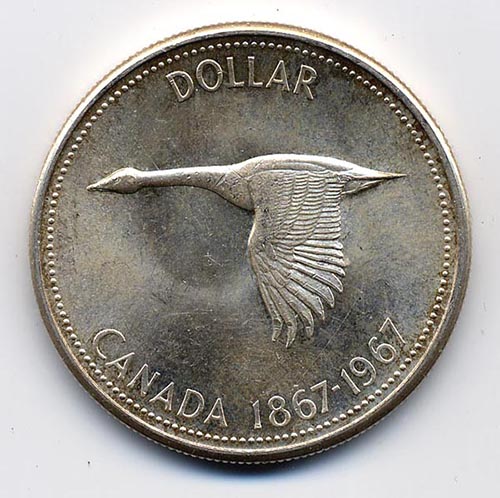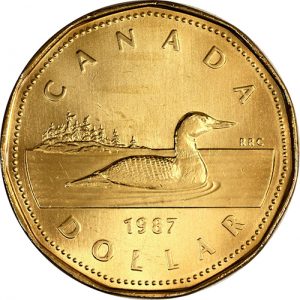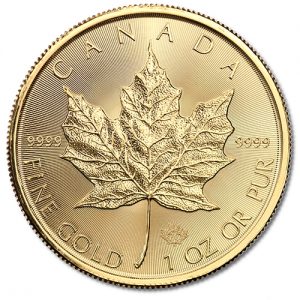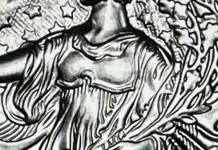
By David Schwager
Every time a Canadian coin appears in your pocket change, you are reminded that Canada bases its money on an American model.
For much of its history, Canada made the same changes to its coins and currency as the United States, with a delay of a few years or decades. For example, Canada switched from large cents to small cents, from half dimes to nickels, and from large-size to small-size currency, in each case following the example of its neighbor. In the last few decades, however—especially in the case of noncirculating coins—the influence often went in the other direction, with the United States learning from the example of the innovative Royal Canadian Mint (RCM).
Competing Coins
The first example starts outside of North America when South Africa’s gold Krugerrand, first minted in 1967, became the world’s first and most popular bullion coin. Canada unveiled a competing gold coin, the Maple Leaf, in 1979. As the Krugerrand increasingly became an unpopular symbol of apartheid, the South African practice of racial separation, in the 1980s, Americans turned to the Maple Leaf for their bullion needs. Seeing an opportunity, the United States Mint obtained congressional approval to make its own bullion coin to undercut these sales, leading to the introduction in 1986 of the American Eagle.

The same year, 1967, also saw Canada’s centennial of Confederation coin program, in which all denominations received 1867/1967 dual dates and one-year commemorative reverses. (Confederation was the 1867 agreement that combined several British North American colonies into the mostly autonomous Dominion of Canada.) This was a circulating commemorative program, with one-cent through 25-cent coins commonly seen in circulation, in addition to the higher denomination collector coins and special sets.
The successful U.S. Bicentennial program several years later largely followed the same playbook, with dual dates, changes only to the reverse, and commemorative coins released into circulation.
Circulating Commemoratives Serve as Stimulus
America’s even more successful circulating commemorative continuity program, the 50 State Quarters® Program of 1999–2008, also had Canadian roots. In 1992, for the 125th anniversary of Confederation, the RCM produced the “Canada 125” coins. Each of the 12 pieces in this one-year series of 25-cent coins had the same obverse and a different reverse illustrating one of the provinces or territories.
In addition to special collector sets, the Canada 125 coins were used in circulation and were a stimulus to collecting. The 50 State Quarters program required multiple years, as it would be impractical to make 50 different reverses in a single year, but otherwise the 50 State series, which was the most popular commemorative coin initiative of this or any other country, had much in common with the Canada 125 coins.
The United States small dollar coin, in contrast, has never been popular. The first attempt, the Susan B. Anthony dollar first released in 1979, was particularly disliked because its color and size led to confusion with the quarter. In 1987, Canada replaced its one-dollar note with a dollar coin, choosing to use the same diameter and thickness as the Anthony dollar for compatibility with American-made vending machines. To avoid confusion with the silver-colored Canadian 25-cent piece, however, the new coin was plated with brass, giving it a distinctive golden color. People quickly accepted the one-dollar coin, soon known as the “loonie” because it bore the image of a loon.
Dollars Follow Suit
When the United States tried again to popularize a dollar coin, the 2000 Sacagawea dollar, the Mint gave it the same brass color as the loonie had. The Sacagawea and later United States small dollars were never accepted widely enough to replace the more popular paper dollars, but the problem of confusion with the quarter had been solved and was no longer a factor.
Most recently, the authorizing legislation for the 2018 Breast Cancer Awareness U.S.

gold commemorative coin specified a 0.750 fine alloy known as pink gold. Canada pioneered the use of pink gold—a mixture of gold and copper with traces of silver—in coinage with selective pink gold plating on its 2012 silver Farewell to the Penny coin. Several other RCM coins continue to use pink gold accents, and the 2018 Breast Cancer Awareness issue will expand on this beginning as an innovative coin made entirely of this composition.
The influence on coins is not entirely one way. The United States Mint’s 2014 Baseball Hall of Fame coin attracted attention worldwide with the way it used its concave-convex shape to accentuate the subject matter. For example, the domed, or convex, side showed a baseball, with the curve of the coin mirroring the curve of the ball. Two years later, the Royal Canadian Mint used the same technique, and almost the same subject, on its 2016 125th Anniversary of the Invention of Basketball emission, with a domed coin displaying a basketball design to good effect.
Further Influential Mintage
In the future, expect the influence to continue. The United States Mint slowly continues to innovate and will study the practices and products of the RCM and other world mints for designs that will better serve its collector customers. Canada, for example, was the first nation to offer .9999 and .99999 pure gold coins. The United States began selling .9999 gold in 2006 and could choose to move to “five nines” coins in the future.
Some of the most important changes, however, are likely to be in circulating coins. The United States has been considering the end of the small cent for over 40 years, and recent discussions mention Canada’s decision to end the one-cent denomination in 2012. Decisions about a circulating one-dollar (or two-dollar or five-dollar) coin will be informed by the experience of our neighbor. When U.S. dollar coins become commonly circulating currency, expect also to start seeing loonies in your pocket change.














